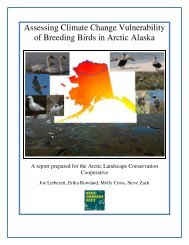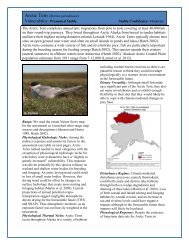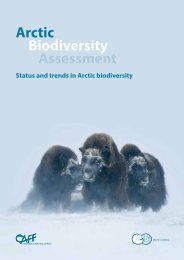Permafrost Terrain Stability and Thermokarst Monitoring: - Arctic LCC
Permafrost Terrain Stability and Thermokarst Monitoring: - Arctic LCC
Permafrost Terrain Stability and Thermokarst Monitoring: - Arctic LCC
Create successful ePaper yourself
Turn your PDF publications into a flip-book with our unique Google optimized e-Paper software.
69. Jorgenson, M.T., Yoshikawa, K., Kanevskiy, M., Shur, Y., Romanovsky, V.,<br />
Marchenko, S., Grosse, G., Brown, J., <strong>and</strong> Jones, B., 2008, <strong>Permafrost</strong> characteristics<br />
of Alaska, in Proceedings of the Ninth International Conference on <strong>Permafrost</strong>, June<br />
2008, Fairbanks, AK, map.<br />
This map is an update to the permafrost distribution map for Alaska using a terrain-unit<br />
approach based on climate <strong>and</strong> surficial geology. It is the third iteration of the statewide<br />
map. The permafrost map is coded with information on surficial geology, mean annual air<br />
temperature, primary soil texture, permafrost extent, ground ice volume, <strong>and</strong> primary<br />
thermokarst l<strong>and</strong>forms. The main map on p. 1 shows the distribution of continuous,<br />
discontinuous, sporadic, <strong>and</strong> isolated permafrost in Alaska along with locations in which the<br />
permafrost thickness is known. On p. 2, there are six accompanying maps that show PRISMbased<br />
mean annual air temperature, surface geology, ground temperatures, ground ice,<br />
pingos, ice wedges, <strong>and</strong> thermokarst l<strong>and</strong>forms. The thermokarst l<strong>and</strong>form map shows 13<br />
types of resolvable features at the mapping scale: (1) deep thermokarst lakes, (2) shallow<br />
thermokarst lakes, (3) basins, (4) troughs, (5) pits, (6) sinks, (7) bogs, (8) fens, (9) thaw<br />
slumps, (10) gullies, (11) water tracks, (12) polygonal troughs, <strong>and</strong> (13) glacial thermokarst.<br />
The authors state that, although this map is an improvement of the prior two mapping<br />
efforts, a better surficial geology map is needed with updated information <strong>and</strong> better spatial<br />
accuracy, more information on terrain-ground ice-temperature-permafrost relationships,<br />
more temperature boreholes, <strong>and</strong> improved spatial models.<br />
70. Kanevskiy, M., Shur, Y., Fortier, D., Jorgenson, M.T., <strong>and</strong> Stephani, E., 2011,<br />
Cryostratigraphy of late Pleistocene syngenetic permafrost (yedoma) in northern<br />
Alaska, Itkillik River exposure: Quaternary Research, v. 75, no. 3, p. 584–596.<br />
This paper provides an overview on the nature <strong>and</strong> distribution of yedoma in the <strong>Arctic</strong>,<br />
describes the characteristics of a yedoma exposure in northern Alaska, <strong>and</strong> provides an<br />
overview map of the potential distribution of yedoma in Alaska. Yedoma permafrost<br />
deposits typically refer to late-Pleistocene syngenetic permafrost, which typically has very<br />
high ground-ice content. The exposure that was studied in northern Alaska represents 40,000<br />
years of undisturbed yedoma formation. The lack of yedoma in certain regions of northern<br />
Alaska forms the basis of the hypothesis that parts of the <strong>Arctic</strong> Coastal Plain were glaciated<br />
during the Pleistocene.<br />
71. Kanevskiy, M., Shur, Y., Jorgenson, M.T., Ping, C.L., Michaelson, G.J., Fortier, D.,<br />
Stephani, E., Dillon, M., <strong>and</strong> Tumskoy, V., 2013, Ground ice in the upper permafrost<br />
of the Beaufort Sea coast of Alaska: Cold Regions Science <strong>and</strong> Technology, v. 85,<br />
p. 56–70.<br />
This paper quantifies ice structures in the five dominant terrain units on the <strong>Arctic</strong> Coastal<br />
Plain: (1) primary surface (silty deposits in the west to gravelly s<strong>and</strong> in the east), (2) low<br />
yedoma foothills, (3) drained lake basins, (4) deltas <strong>and</strong> tidal flats, <strong>and</strong> (5) eolian s<strong>and</strong><br />
dunes. Wedge-ice volumes <strong>and</strong> total volumetric ice were calculated. Wedge ice was the<br />
dominant form of massive ice, ranging from 3 to 50 percent, <strong>and</strong> occurring in nearly all<br />
terrains. Other types of massive ice included thermokarst cave ice, ice core pingos, <strong>and</strong><br />
folded massive ice. Most of the soils were classified as frost-susceptible silts, resulting in<br />
extremely ice-rich permafrost dominated by ataxitic cryostructure. Ice content was notably<br />
lower in young drained lake basins, deltas, <strong>and</strong> tidal flats. The authors discussed formation<br />
<strong>and</strong> calculation of the size of the transition layer, which is the ice-rich upper part of the<br />
permafrost, the formation of which greatly elevates the l<strong>and</strong>scape.<br />
28








